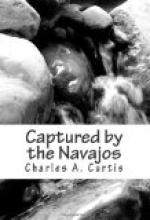It was the 3d of October when the boy corporals and myself, mounted on sturdy Mexican ponies, rode out of Fort Marcy for our new station, one hundred miles due west. The regimental band escorted the company through the plaza and for a mile on our way, playing, after immemorial custom, “The Girl I Left Behind Me,” and adding, I thought with a vein of irony, “Ain’t Ye Glad You’ve Got Out th’ Wilderness?”
On the morning of the 8th, after four days of gradual and constant ascent from the valley of the Rio Grande, which we had forded at San Ildefonso, we began the slower ascent of the most difficult portion of our march.
The woods were full of wild turkeys and mountain grouse, made fat on the pine-nuts, and Frank and Henry and the soldier huntsmen secured a generous supply for our first meal in our new military home.
It took us from early morning until noon of the last day’s march to reach the highest point of the road. What with the frequent halts for the men to fasten a rope to the wagon-poles and aid the severely taxed mules up the steepest places, to fill gullies and sloughs with stones and brush, to pry mired wheels up to firm ground, and repair broken harnesses and wagons, we were over half a day in going a distance which could have been accomplished in two hours by soldiers unencumbered with a baggage and supply train.
The downward march on the western slope of the mountain-range was rapidly made over a smooth road through a continuous avenue of overarching forest trees, and without a halt. From the lower limit of the forest we caught the first glimpse of the Great Valleys. The valley before us was fourteen miles long, and of a nearly uniform width of eight miles. It was almost surrounded by mountains; in fact, while there were many trails leading out of it, there was but one practicable wagon-road—that by which we had entered. But at the southern extremity there was a precipitous canon, through which flowed a considerable stream. To the west was another canon, a dry one, called La Puerta—the doorway—which led into the second valley, called the Valley of San Antonio.
The Great Valley, on the eastern edge of which I had halted the company for a few moments’ rest and observation, was lower through the centre than at the sides. It was not unlike an oblong platter, and was absolutely treeless, except that opposite us a bold, pine-clad point jutted out from the western mountain-range about three miles, like a headland into the sea.
The whole valley was verdant with thick grass. The two boys, sitting on their ponies a few yards in advance of the company line, were in raptures over the prospect.
“This is the first bit of country I’ve seen in New Mexico that looks like Vermont,” said Frank.
“Yes, and what a change in the space of a few miles!” observed Henry. “On the opposite side of this range were only bunch-grass, cactus, and sand, and here we have fine turf and waving grass. What are those objects in that farther corner, sir?” he continued, turning to me and pointing to the southwest. “Look like deer or grazing cattle.”




